Kingdoms Of Amalur: Reckoning – E3 Preview
by Mark R
 Every so often, apathy, curiosity and urgency come together and create something exquisite when we least expect it. It may be the result of only having five minutes to grab a quick snack and, with very little available in the fridge and no real desire to put any effort into cooking, you throw together some mis-matched foods only to discover that what you’ve created is culinary genius. In this particular case, it was having only thirty five minutes until my next appointment at E3, being too tired to sprint from my present location to anything else that I’d earmarked earlier in the day, and the fact that my VIP pass for EA meant that I could queue-jump to get straight in to the presentation that was about to start.
Every so often, apathy, curiosity and urgency come together and create something exquisite when we least expect it. It may be the result of only having five minutes to grab a quick snack and, with very little available in the fridge and no real desire to put any effort into cooking, you throw together some mis-matched foods only to discover that what you’ve created is culinary genius. In this particular case, it was having only thirty five minutes until my next appointment at E3, being too tired to sprint from my present location to anything else that I’d earmarked earlier in the day, and the fact that my VIP pass for EA meant that I could queue-jump to get straight in to the presentation that was about to start.
The name on the door was Kingdoms of Amalur: Reckoning and, I’ll be completely honest, I neither knew anything about who was developing it or even what genre it was. This wasn’t from ignorance, but more from not having any appointments for EA booked in advance and so there was nothing specific to research. The door opened and we were ushered in to a beautifully themed presentation booth with seating that looked as though it had been carved from centuries old trees and stone, decorated with skulls and other fantastical trinkets. The lighting was akin to one of those special shops in Amsterdam, but there was already a good feeling about this presentation. Could this be my sleeper hit for E3 2011?
Quite honestly, yes.
The first things to grab me were the incredible visuals. Bringing a blend of the highly saturated set pieces of Overlord, wonderfully detailed surroundings of Oblivion and the story book aspect of Fable 2 to the table, the beautifully crafted characters and landscapes screamed quality without sacrificing any sense of realism, at least as far as fantasy is concerned. The combat was snappy, quirky and appeared to have just enough of a JRPG angle to make it interesting, without verging on the ridiculous. So far, within the first few seconds of the introductory video, prior to the gameplay presentation, there was enough that I needed to know more.
 While it wasn’t known to me as I stepped into the booth, Reckoning boasts an incredible think-tank of incredibly talented and respected individuals including best selling fantasy author R. A. Salvatore, responsible for many famed series such as The Icewind Dale Trilogy, who penned a 10,000 year story bible for the game and acts as Executive Creator Of Worlds. The Executive Art Director is none other than comic artist extraordinaire, Spawn creator, and action figure legend, Todd McFarlane. Fans of the Elder Scrolls series may recognise Ken Rolston, Senior Designer at Big Huge Games, who served as Lead Designer at Bethesda and worked on both Morrowind and Oblivion. With these three fantasy powerhouses working together, it’s no wonder that Kingdoms Of Amalur quickly took my breath away.
While it wasn’t known to me as I stepped into the booth, Reckoning boasts an incredible think-tank of incredibly talented and respected individuals including best selling fantasy author R. A. Salvatore, responsible for many famed series such as The Icewind Dale Trilogy, who penned a 10,000 year story bible for the game and acts as Executive Creator Of Worlds. The Executive Art Director is none other than comic artist extraordinaire, Spawn creator, and action figure legend, Todd McFarlane. Fans of the Elder Scrolls series may recognise Ken Rolston, Senior Designer at Big Huge Games, who served as Lead Designer at Bethesda and worked on both Morrowind and Oblivion. With these three fantasy powerhouses working together, it’s no wonder that Kingdoms Of Amalur quickly took my breath away.
Taking control of the presentation was Ian Frazier, Lead Designer at Big Huge Games, and guiding us through the gameplay with Xbox controller in hand was Lead Combat Designer, Joe Quadara.
Set in an area known as the Faelands, Reckoning is a single player, open world RPG where you take on the role of the fateless one. Crawling from a pile of corpses after having been resurrected by a machine called The Well Of Souls which, until that point, had failed to resurrect anyone, your character is torn free from fate, giving you the ability to not only forge your own destiny but also the fate of those around you. Rather than having fate and destiny thrown in as a pointless MacGuffin, both serve as pivotal gameplay elements and will shape the way your character evolves over time as well as dictate how your combat style develops.
 |
 |
 |
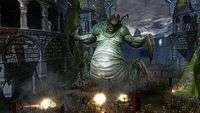 |
 |
 |
The five geographic locations within the game each have their own identities, from the physical attributes of the landscape down to the cities and villages within, as well as the various creatures and citizens who inhabit them. As a way of adding realism to the game, the townsfolk and villagers will all have their own routines and schedules to play out. As well as each area having its own distinct look and feel, there are over one hundred and twenty dungeons throughout the game, all individually hand-crafted with no rubber-stamping.
 Starting off in typical RPG style, the character creation area offers a choice between male and female along with a selection of four different races. As you’d expect from an RPG, your character can be customised to suit your own preference, with scores of different face shapes, skin tones, hairstyles, piercings, tattoos, make-up and whole host of additional attributes so you could quite literally spend hours fine-tuning who you choose to spend the next hundred or so hours with. For those who prefer to run with a generic character and get stuck in to the action, there are a variety of presets on offer.
Starting off in typical RPG style, the character creation area offers a choice between male and female along with a selection of four different races. As you’d expect from an RPG, your character can be customised to suit your own preference, with scores of different face shapes, skin tones, hairstyles, piercings, tattoos, make-up and whole host of additional attributes so you could quite literally spend hours fine-tuning who you choose to spend the next hundred or so hours with. For those who prefer to run with a generic character and get stuck in to the action, there are a variety of presets on offer.
Along with the main quest, beginning with your own rebirth, there are six joinable factions which boast their own particular story threads resulting in a game with, quite literally, hundreds of side quests. Depending on which faction you have an allegiance to, and how you choose to steer your character, the replay value from what we’ve been told would appear to be considerable although there isn’t exactly the same option for playing through as a different class, as Ian Frazier tells us:
“We don’t have traditional character classes in Reckoning; instead we have destinies. How you choose to invest in these abilities makes a big difference, not just in your moment to moment combat but in what destinies you unlock. Destinies are sort of a dynamic character class so, rather than starting the game and saying ‘I’m gonna be a Paladin’, and hoping that it doesn’t suck in that particular game, you get to play a little bit up front, get to experience the different play styles and the game will adapt to your choices, unlocking destinies based on what you’ve decided to invest in. At that point, you can then steer your course, change your destiny and upgrade it however you want over the course of the game.”
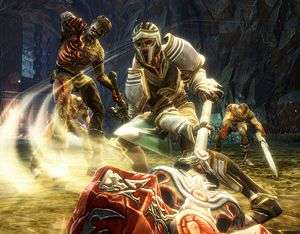 Theoretically, if you start the game and adopt a melee style character but find that, through the various enemies you encounter along the way, you start to use magic for ranged combat more than you do up-close sword smashing, your character will develop in line with those choices. While it may not offer the opportunity to play through as a different class entirely, it does allow the player to go down an entirely new route based on how they proceed. This is something that I find particularly interesting after having stuck with my usual heavy armour, dual-sword wielding character in Two Worlds II and yet found myself using more spells as the game progressed while still, essentially, being a melee character. With Reckoning, however, my character would shift balance according to my playing style.
Theoretically, if you start the game and adopt a melee style character but find that, through the various enemies you encounter along the way, you start to use magic for ranged combat more than you do up-close sword smashing, your character will develop in line with those choices. While it may not offer the opportunity to play through as a different class entirely, it does allow the player to go down an entirely new route based on how they proceed. This is something that I find particularly interesting after having stuck with my usual heavy armour, dual-sword wielding character in Two Worlds II and yet found myself using more spells as the game progressed while still, essentially, being a melee character. With Reckoning, however, my character would shift balance according to my playing style.
Along with a series of combat based abilities – there are sixty variations of Might, Finesse and Sorcery – there are a selection of non-combat skills from which to choose as you progress your character, and which serve to spice up gameplay considerably. Detect Hidden, for example, will unveil any hidden treasures as well as secret doors or traps, and display them clearly on your mini-map while Dispel lets you disable magical traps which, if you fail in your attempts to dispel them, will curse you or blow up in your face. The Stealth skill allows for more than just pickpocketing and trespassing, as Joe demonstrated by pulling off a beautifully executed sneak kill from behind. As you add more points to each skill, they become more powerful and easier to perform, with less chance of failure.
 |
 |
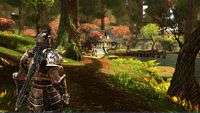 |
 |
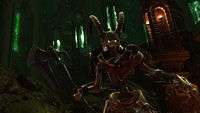 |
 |
As someone who adores collecting legendary weapons and is forever trying to better whatever weapons are currently being carried around in the neverending backpack, it was music to my ears to be told that Reckoning featured “eight gazillion items that can be generated as well as hundreds of hand-crafted items”, which meant I would likely spend another hundred or so hours on top of questing time doing nothing more than looting and comparing weapons. It’s also worthy of note that it’s not necessary to equip an item in order to compare it with whatever you already have in your inventory, as this can be done simply by looking at the item’s stats prior to looting, although not in the same at-a-glance sense as Borderlands with its convenient popups.
 The inclusion of weapon and armour sets is also a welcomed addition, whereby each newly acquired item from a set will provide a cumulative bonus until all pieces are collected and equipped, at which point a further bonus will kick in. The loot hound in me, which isn’t exactly hidden, started to perform somersaults as I sat on my themed bench, itching to take hold of the controller and pore through the inventory like an excited schoolboy with his first Penthouse.
The inclusion of weapon and armour sets is also a welcomed addition, whereby each newly acquired item from a set will provide a cumulative bonus until all pieces are collected and equipped, at which point a further bonus will kick in. The loot hound in me, which isn’t exactly hidden, started to perform somersaults as I sat on my themed bench, itching to take hold of the controller and pore through the inventory like an excited schoolboy with his first Penthouse.
The weapons themselves look stunning, and Joe quickly jumped to the Sagecrafting area of his inventory to “socket” his sword with a gem, enchanting it with fire as the blade of the sword became engulfed with flames. Socketing is just one area of crafting that Reckoning has to offer, along with blacksmithing. Every weapon and piece of armour can be broken down to its component parts and used to create an entirely new item that better suits your particular style of play, and crystal shards are merged to create gems which bring their own additional attributes to whatever piece of equipment plays host.
One particularly interesting aspect of the game, that probably had countless story enthusiasts squirming in disgust, was Ian’s revelation whereby quest-critical dialogue lines would be shifted to the top of the dialogue tree and highlighted in blue, allowing the less discerning gamer to effectively blitz through and deal only with whatever conversation threads are necessary to the quest in hand. As someone who only chooses to immerse themselves in a story if said story is actually worthwhile, even I found it to be a bold move although I suspect that I would still rather explore all avenues for hidden nuggets of information.
As far as combat is concerned, Reckoning is both visually dynamic, drawing a lot of inspiration from the action genre, and somewhat intuitive insofar as it neither requires complex combos to be pulled off, nor is it a button masher, as Ian explains…
“Don’t be confused, this is not an action game, I mean at the end of the day it IS still an RPG and your moment to moment combat is determined not by button combos – we don’t do that at all, so no memorising X, X, Y, Y, B – but by really basic input from your controller and your choices over time such as the abilities you’ve chosen to invest in, the equipment you’ve chosen to wear and the destiny that you’re using at this particular time.”
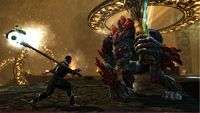 |
 |
 |
 |
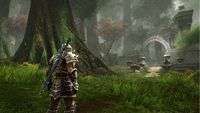 |
 |
While I obviously can’t comment on how fluid the combat gameplay is, visually… it is stunning. Standard attack moves coupled with special finishing movies and the all-too-familiar, but mostly welcomed, mid-air slow downs make for more of a spectacle than your run of the mill RPG battle. With every enemy that you take down, you gain more fate energy. This energy accumulates to the point where, once you have enough, you can pull off a special move called a Reckoning, described by Ian as briefly turning you into “an all purpose badass for as long as you have fate energy to burn” and the resulting moves are breathtaking. You become more durable, perform ridiculous amounts of damage, weapons take on something of an ethereal form and as you destroy each enemy, their fate unravels in a blue wisp of illumination, which you absorb along with a huge XP bonus.
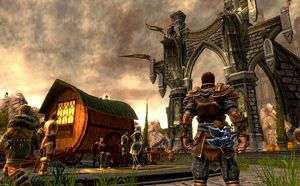 The presentation we were shown was utilising a pre-alpha model of the game but, from what I could see, there really wasn’t much to complain about. While it may be early days to make such a judgement, I walked away from the Reckoning presentation secure in the knowledge that no other E3 game was going to capture my attention as much as this had, but was also disappointed that I’d have to wait until next year to get my hands on it.
The presentation we were shown was utilising a pre-alpha model of the game but, from what I could see, there really wasn’t much to complain about. While it may be early days to make such a judgement, I walked away from the Reckoning presentation secure in the knowledge that no other E3 game was going to capture my attention as much as this had, but was also disappointed that I’d have to wait until next year to get my hands on it.
Kingdoms Of Amalur: Reckoning is currently slated for a Q1 2012 release on Xbox 360, Playstation 3 and PC, with a full scale MMORPG set in the greater world of Amalur also in the works.
Games featured in this article
For more information on any of the games featured in this article, click on any of the links below
Last five articles by Mark R
- From Acorns to Fish
- Alone In The Dark
- Why Borderlands is Better Than Borderlands 2
- Falling Short
- The Division: A Guide to Surviving the Dark Zone Solo
























You had me at aspects of Overlord, Oblivion and Fable II. I’ve not heard a great deal about this game, but a lot of these RPGs get considerably less attention than they deserve without the names Elder Scrolls, Bioware or Peter Molyneux attached to them in some way, so that’s not really startling. The screenshots are very impressive, in comparison to the visuals of a lot of these sorts of games, and if the story and gameplay is similarly good then this could be, if not a hit, then at least a really good game. Though with EA attached to it, you can almost be certain they want to milk it for sequels and so forth and will start pushing this hard nearer to release.
Definitely going to have to keep an eye on this.
WANT!
Definitely one for my “Must Have” list! I can’t wait to get my paws on this!
This sounds exactly like the sort of game you’d love, Mark; massive RPG with loads to do, explore and ways to develop your character in repeat playthroughs. Sounds most excellent, and though I have no interest in playing it I’ll keep an eye on it and hope it gets the recognition it deserves